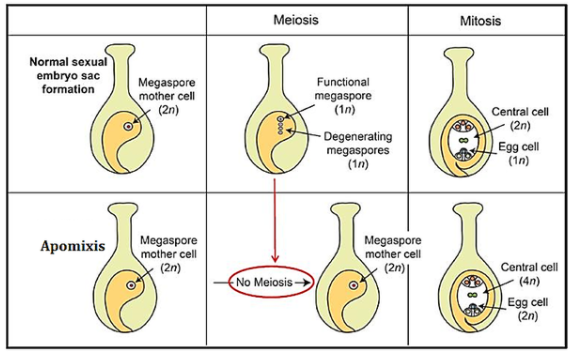
Which of the following in non-recurrent apomixis?
A. Amphimixis
B. Haploid Parthenogenesis
C. Aneuspory
D. None of the above
Answer
482.1k+ views
Hint: In plants, the fusion of male gametes (pollen grains) and female gamete (ovary) gets fertilized to form a fruit. The pollens are there in the anther of the stamen. While the ovaries are present in the female gametophyte. Upon their fusion, the diploid embryo is formed which will give us fruit on maturation. In animals, the haploid sperm and egg will fuse to form another life called an embryo. The process of development of diploid embryos without fertilization is Apomixis.
Complete answer:
To solve this question, we need to learn about amphimixis, haploid parthenogenesis, aneuspory and then correlate with non-recurrent apomixis.
Non-recurrent apomixis: In this type of apomixis, the embryo develops directly from the haploid egg cell without fertilization which results in a haploid embryo. The plants are haploid and sterile. Non-recurrent apomixis is the direct development of an embryo from an unfertilized egg hence Haploid parthenogenesis is non-recurrent apomixis.

Let us examine the terms in the question.
> Option A: Amphimixis: It is the fusion of male and the female gametes in sexual reproduction. The fusion of the gametes occurs during fertilization which results in the formation of a zygote. The zygote develops into an offspring that is genetically distinct from the parent because of recombination. Diploid cells of sporophyte from haploid gametophytes, which produce male and female gametes. Syngamy i.e. fusion of haploid gametes helps in restoration of the diploid sporophyte.
> Option B: Haploid parthenogenesis: It is an asexual reproduction in which an unfertilized egg forms a new individual. A new individual develops here without fertilization. The offspring develop from haploid eggs to produce haploid adults. Eg Bees, nematodes and some plants.
> Option C: Aneuspory is a condition in which a megaspore mother cell produces embryo sac by mitosis. A diploid embryo sac is aneuspory due to mitosis.
Hence, The correct answer is option (B).
Note: Parthenogenesis can work on diploid and haploid both. There is natural and artificial parthenogenesis. When the animals or plants do not have sex chromosomes they will do the natural parthenogenesis to make progenies. The artificial parthenogenesis is done in the labs to make the fertilization earlier or delayed to study their features. Temperature can induce parthenogenesis in plants when taken from -30 degree to -10 degree. UV light and electrical shocks can also cause it.
Complete answer:
To solve this question, we need to learn about amphimixis, haploid parthenogenesis, aneuspory and then correlate with non-recurrent apomixis.
Non-recurrent apomixis: In this type of apomixis, the embryo develops directly from the haploid egg cell without fertilization which results in a haploid embryo. The plants are haploid and sterile. Non-recurrent apomixis is the direct development of an embryo from an unfertilized egg hence Haploid parthenogenesis is non-recurrent apomixis.

Let us examine the terms in the question.
> Option A: Amphimixis: It is the fusion of male and the female gametes in sexual reproduction. The fusion of the gametes occurs during fertilization which results in the formation of a zygote. The zygote develops into an offspring that is genetically distinct from the parent because of recombination. Diploid cells of sporophyte from haploid gametophytes, which produce male and female gametes. Syngamy i.e. fusion of haploid gametes helps in restoration of the diploid sporophyte.
> Option B: Haploid parthenogenesis: It is an asexual reproduction in which an unfertilized egg forms a new individual. A new individual develops here without fertilization. The offspring develop from haploid eggs to produce haploid adults. Eg Bees, nematodes and some plants.
> Option C: Aneuspory is a condition in which a megaspore mother cell produces embryo sac by mitosis. A diploid embryo sac is aneuspory due to mitosis.
Hence, The correct answer is option (B).
Note: Parthenogenesis can work on diploid and haploid both. There is natural and artificial parthenogenesis. When the animals or plants do not have sex chromosomes they will do the natural parthenogenesis to make progenies. The artificial parthenogenesis is done in the labs to make the fertilization earlier or delayed to study their features. Temperature can induce parthenogenesis in plants when taken from -30 degree to -10 degree. UV light and electrical shocks can also cause it.
Recently Updated Pages
Master Class 11 Accountancy: Engaging Questions & Answers for Success

Express the following as a fraction and simplify a class 7 maths CBSE

The length and width of a rectangle are in ratio of class 7 maths CBSE

The ratio of the income to the expenditure of a family class 7 maths CBSE

How do you write 025 million in scientific notatio class 7 maths CBSE

How do you convert 295 meters per second to kilometers class 7 maths CBSE

Trending doubts
Which are the Top 10 Largest Countries of the World?

What is a transformer Explain the principle construction class 12 physics CBSE

Differentiate between homogeneous and heterogeneous class 12 chemistry CBSE

Draw a labelled sketch of the human eye class 12 physics CBSE

What are the major means of transport Explain each class 12 social science CBSE

What is the Full Form of PVC, PET, HDPE, LDPE, PP and PS ?




